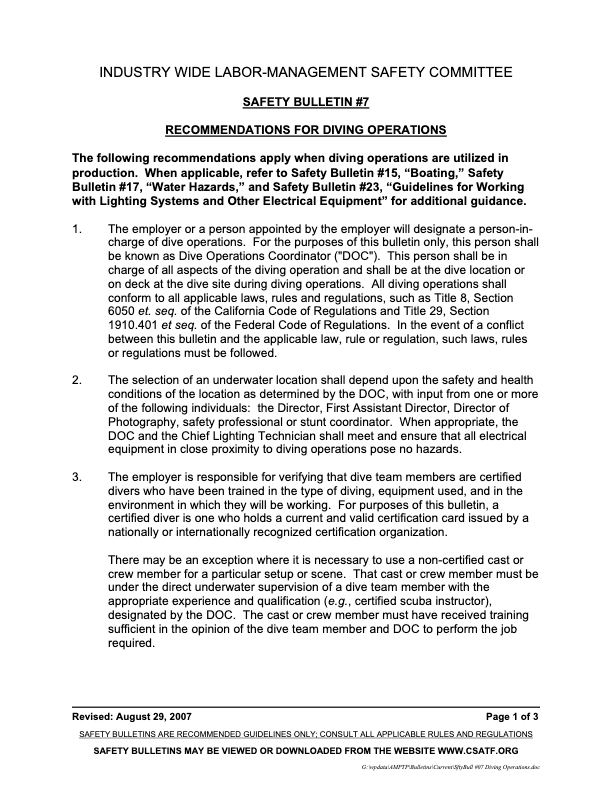Safety Bulletin

Guidelines
The following recommendations apply when diving operations are utilized in production. When applicable, refer to Safety Bulletin: Boating and Watercraft, Safety Bulletin: Water Hazards, and Safety Bulletin: Portable Power Distribution Systems for additional guidance.
- The employer or a person appointed by the employer will designate a person-in- charge of dive operations. For the purposes of this bulletin only, this person shall be known as Dive Operations Coordinator (“DOC”). This person shall be in charge of all aspects of the diving operation and shall be at the dive location or on deck at the dive site during diving operations. All diving operations shall conform to all applicable laws, rules and regulations, such as Title 8, Section 6050 et. seq. of the California Code of Regulations and Title 29, Section 1910.401 et seq. of the Federal Code of Regulations. In the event of a conflict between this bulletin and the applicable law, rule or regulation, such laws, rules or regulations must be followed.
- The selection of an underwater location shall depend upon the safety and health conditions of the location as determined by the DOC, with input from one or more of the following individuals: the Director, First Assistant Director, Director of Photography, safety professional or stunt coordinator. When appropriate, the DOC and the Chief Lighting Technician shall meet and ensure that all electrical equipment in close proximity to diving operations pose no hazards.
- The employer is responsible for verifying that dive team members are certified divers who have been trained in the type of diving, equipment used, and in the environment in which they will be working. For purposes of this bulletin, a certified diver is one who holds a current and valid certification card issued by a nationally or internationally recognized certification organization. There may be an exception where it is necessary to use a non-certified cast or crew member for a particular setup or scene. That cast or crew member must be under the direct underwater supervision of a dive team member with the appropriate experience and qualification (e.g., certified scuba instructor), designated by the DOC. The cast or crew member must have received training sufficient in the opinion of the dive team member and DOC to perform the job required.
- The DOC shall establish and make available an Emergency Action Plan, including the nearest location of a recompression chamber, proper methods of transportation to that chamber, and emergency contact information.
- Prior to each day’s diving operations, appropriate safeguards should be considered and communicated to all involved in the underwater activities.
- The DOC shall brief dive team members of dive objectives, hazards, environmental conditions, any modifications to diving or emergency procedures likely to affect the safety of the diving operations, and the necessity of immediately reporting any physical problems or adverse physiological effects, including symptoms of pressure-related injuries.
- Properly trained and equipped safety diver(s) shall be available as determined by the DOC. For purposes of this bulletin, a safety diver is a diver at the dive location, not in the dive rotation, who is capable of rendering immediate assistance to a diver in the water.
- The employer shall ensure that adequate quantities of medical oxygen (100% O2) with appropriate methods of administration, and personnel trained in the use of such oxygen are immediately available during the diving operations.
- A diver shall be accompanied in the water by another diver throughout the diving operation (a “buddy” system).
- To avoid decompression illness, divers shall wait the appropriate period of time, as determined by the DOC, between dive operations and travel at altitude (including travel by air and land).
- The DOC shall maintain a master log, which includes diver name, entry time, dive depth, and exit time. Individual logs shall be kept on behalf of all divers. Individual and master logs shall be reconciled on a dive-by-dive basis.
- A functional underwater diver recall system shall be made available, tested and demonstrated on site prior to dive operations.
- All dive equipment shall be inspected prior to each dive.
- The employer shall have standby breathing equipment and safety diver(s) immediately available underwater when the possibility of trapped divers exists.
- Each diver shall have a functional depth gauge, an underwater time-keeping device, an alternate air supply, and a pressure gauge for monitoring SCUBA tank pressure. Each diver shall also have the capability of achieving and maintaining positive buoyancy.
- Diving tanks, when transported to and from location and when not in use, will be secured in such a manner as to prevent them from rolling or allowing the valves to be struck by other objects. When not in use, diving tanks shall be stored in the shade.
- All dive team members shall be trained and current in cardiopulmonary resuscitation (CPR), diver rescue techniques, and diving-related first aid.
- All dive team members must have passed a current (within the preceding twelve months) physical examination, have been declared medically fit to engage in diving operations, and be approved for the dive by the DOC.
